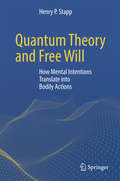- Table View
- List View
Quantum Steampunk: The Physics of Yesterday's Tomorrow
by Nicole Yunger HalpernThe Industrial Revolution meets the quantum-technology revolution! A steampunk adventure guide to how mind-blowing quantum physics is transforming our understanding of information and energy.Victorian era steam engines and particle physics may seem worlds (as well as centuries) apart, yet a new branch of science, quantum thermodynamics, reenvisions the scientific underpinnings of the Industrial Revolution through the lens of today's roaring quantum information revolution. Classical thermodynamics, understood as the study of engines, energy, and efficiency, needs reimagining to take advantage of quantum mechanics, the basic framework that explores the nature of reality by peering at minute matters, down to the momentum of a single particle. In her exciting new book, intrepid Harvard-trained physicist Dr. Nicole Yunger Halpern introduces these concepts to the uninitiated with what she calls "quantum steampunk," after the fantastical genre that pairs futuristic technologies with Victorian sensibilities. While readers follow the adventures of a rag-tag steampunk crew on trains, dirigibles, and automobiles, they explore questions such as, "Can quantum physics revolutionize engines?" and "What deeper secrets can quantum information reveal about the trajectory of time?" Yunger Halpern also describes her own adventures in the quantum universe and provides an insider's look at the work of the scientists obsessed with its technological promise. Moving from fundamental physics to cutting-edge experimental applications, Quantum Steampunk explores the field's aesthetic, shares its whimsy, and gazes into the potential of a quantum future. The result is a blast for fans of science, science fiction, and fantasy.
Quantum Stochastics
by Mou-Hsiung ChangThe classical probability theory initiated by Kolmogorov and its quantum counterpart, pioneered by von Neumann, were created at about the same time in the 1930s, but development of the quantum theory has trailed far behind. Although highly appealing, the quantum theory has a steep learning curve, requiring tools from both probability and analysis and a facility for combining the two viewpoints. This book is a systematic, self-contained account of the core of quantum probability and quantum stochastic processes for graduate students and researchers. The only assumed background is knowledge of the basic theory of Hilbert spaces, bounded linear operators, and classical Markov processes. From there, the book introduces additional tools from analysis, and then builds the quantum probability framework needed to support applications to quantum control and quantum information and communication. These include quantum noise, quantum stochastic calculus, stochastic quantum differential equations, quantum Markov semigroups and processes, and large-time asymptotic behavior of quantum Markov semigroups.
Quantum Strangeness: Wrestling with Bell's Theorem and the Ultimate Nature of Reality (The\mit Press Ser.)
by George S. GreensteinA physicist's efforts to understand the enigma that is quantum mechanics.Quantum mechanics is one of the glories of our age. The theory lies at the heart of modern society. Quantum mechanics is one of our most valuable forecasters—a “great predictor.” It has immeasurably altered our conception of the natural world. Its philosophical implications are earthshaking. But quantum mechanics steadfastly refuses to speak of many things; it deals in probabilities rather than giving explicit descriptions. It never explains. Einstein, one of its creators, considered the theory incomplete. Even now, many years after the creation of quantum mechanics, physicists continue to argue about it. Astrophysicist George Greenstein has been both fascinated and confused by quantum mechanics for his entire career. In this book, he describes, engagingly and accessibly, his efforts to understand the enigma that is quantum mechanics. The fastest route to the insight into the ultimate nature of reality revealed by quantum mechanics, Greenstein writes, is through Bell's Theorem, which concerns reality at the quantum level; and Bell's 1964 discovery drives Greenstein's quest. Greenstein recounts a scientific odyssey that begins with Einstein, continues with Bell, and culminates with today's push to develop an industry of quantum machines. Along the way, he discusses spin, entanglement, experimental metaphysics, and quantum teleportation, often with easy-to-grasp analogies. We have known for decades that the world of the quantum was strange, but, Greenstein says, not until John Bell came along did we know just how strange.
Quantum Superfield Supersymmetry (Fundamental Theories of Physics #202)
by Albert PetrovThis book presents the superfield description of various supersymmetric field theory models in three- and four-dimensional space-times. A mapping between superfield and component formulations of supersymmetric field theories is discussed. The author also describes the methodology for calculating quantum corrections in these theories employing supergraph formalism and functional methods, and illustrates these approaches with many detailed examples of how such calculations are performed for various superfield models.
Quantum Supremacy: How the Quantum Computer Revolution Will Change Everything
by Michio KakuNEW YORK TIMES BESTSELLER • An exhilarating tour of humanity's next great technological achievement—quantum computing—which may supercharge artificial intelligence, solve some of humanity's biggest problems, like global warming, world hunger, and incurable disease, and eventually illuminate the deepest mysteries of science, by the bestselling author of The God Equation. • &“Expertly describes and rectifies common misconceptions about quantum computing." —Science "[Kaku's] lucid prose and thought process make abundant sense of this technological turning point.&” —The New York Times Book ReviewThe runaway success of the microchip may finally be reaching its end. As shrinking transistors approach the size of atoms, the phenomenal growth of computational power inevitably collapses. But this change heralds the birth of a revolutionary new type of computer, one that calculates on atoms themselves.Quantum computers promise unprecedented gains in computing power, enabling advancements that could overturn every aspect of our daily lives. While the media has mainly focused on their startling potential to crack any known encryption method, the race is already on to exploit their incredible power to revolutionize industry. Automotive makers, medical researchers, and consulting firms are all betting on quantum computing to design more efficient vehicles, create life-saving new drugs, and streamline businesses. But this is only the beginning. Quantum computing could be used to decode the complex chemical processes needed to produce cheap fertilizers and unleash a second Green Revolution; create a super battery that will enable the Solar Age; or design nuclear fusion reactors to generate clean, safe, renewable energy. It may even unravel the fiendishly difficult protein folding that lies at the heart of as-yet-incurable diseases like Alzheimer&’s, ALS, and Parkinson&’s. Already, quantum computers are being put to work to help solve the greatest mystery in science—the origin of the universe.There is no single problem humanity faces that might not be addressed by quantum computers. With his signature clarity and enthusiasm, Dr. Michio Kaku, who has spent his entire professional life working on the quantum theory, tells the thrilling story of this exciting scientific frontier and the race to claim humanity&’s future.
Quantum Systems in Chemistry and Physics: Progress in Methods and Applications
by Jean Maruani Erkki J. Brändas Gerardo Delgado-Barrio Kiyoshi Nishikawa Piotr PiecuchQuantum Systems in Chemistry and Physics: Progress in Methods and Applications is a collection of 33 selected papers from the scientific contributions presented at the 16th International Workshop on Quantum Systems in Chemistry and Physics (QSCP-XVI), held at Ishikawa Prefecture Museum of Art in Kanazawa, Japan, from September 11th to 17th, 2011. The volume discusses the state of the art, new trends, and the future of methods in molecular quantum mechanics and their applications to a wide range of problems in physics, chemistry, and biology. The breadth and depth of the scientific topics discussed during QSCP-XVI appears in the classification of the contributions in six parts: I. Fundamental Theory II. Molecular Processes III. Molecular Structure IV. Molecular Properties V. Condensed Matter VI. Biosystems. Quantum Systems in Chemistry and Physics: Progress in Methods and Applications is written for advanced graduate students as well as for professionals in theoretical chemical physics and physical chemistry. The book covers current scientific topics in molecular, nano, material, and bio sciences and provides insights into methodological developments and applications of quantum theory in physics, chemistry, and biology that have become feasible at end of 2011.
Quantum Systems in Physics, Chemistry, and Biology
by Jean Maruani Erkki J. Brändas Gerardo Delgado-Barrio Alia Tadjer Rossen PavlovThis book reviews the most significant developments in quantum methodology applied to a broad variety of problems in chemistry, physics, and biology. In particular, it discusses atomic and molecular structure, dynamics and spectroscopy as well as applications of quantum theory to biological and condensed matter systems. The volume contains twenty-four selected, peer-reviewed contributions based on the presentations given at the Twentieth International Workshop on Quantum Systems in Chemistry, Physics, and Biology (QSCP-XX), held in Varna, Bulgaria, in September 2015. It is divided into five sections containing the most relevant papers written by leading experts in the fields. This book will appeal to advanced graduate students, researchers, and academics involved in theoretical, quantum or statistical and computational chemical physics and physical chemistry.
Quantum Systems under Gravitational Time Dilation
by Magdalena ZychThis thesis introduces a new theoretical tool to explore the notion of time and temporal order in quantum mechanics: the relativistic quantum "clock" framework. It proposes novel thought experiments showing that proper time can display quantum features, e. g. when a "clock" runs different proper times in superposition. The resulting new physical effects can be tested in near-future laboratory experiments (with atoms, molecules and photons as "clocks"). The notion of time holds the key to the regime where quantum theory and general relativity overlap, which has not been directly tested yet and remains largely unexplored by the theory. The framework also applies to scenarios in which causal relations between events become non-classical and which were previously considered impossible to address without refuting quantum theory. The relativistic quantum "clock" framework offers new insights into the foundations of quantum theory and general relativity.
Quantum Technologies and Military Strategy (Advanced Sciences and Technologies for Security Applications)
by Ajey LeleThis book is about the strategic relevance of quantum technologies. It debates the military-specific aspects of this technology. Various chapters of this book cohere around two specific themes. The first theme discusses the global pattern of ongoing civilian and military research on quantum computers, quantum cryptography, quantum communications and quantum internet. The second theme explicitly identifies the relevance of these technologies in the military domain and the possible nature of quantum technology-based weapons. This thread further debates on quantum (arms) race at a global level in general, and in the context of the USA and China, in particular. The book argues that the defence utility of these technologies is increasingly becoming obvious and is likely to change the nature of warfare in the future.
Quantum Teleportation Under Noise: Key Technologies and Applications
by Dongfen LiThis book offers a deep dive into quantum teleportation and immune noise models, providing cutting-edge solutions to challenges in noisy quantum communication systems. It covers advanced theories and practical methods for building robust, high-fidelity quantum channels that ensure secure communication even in noisy environments, making it a vital resource for researchers and professionals in quantum information science. Key topics include quantum teleportation protocols, immune noise models, quantum information splitting, and multi-degree-of-freedom quantum teleportation. By developing a unified framework for high-fidelity quantum channels, the book tackles major issues like "entanglement death," decoherence, and channel capacity limitations. It offers solutions to improve quantum state fidelity, channel performance, and security, enhancing the practicality of quantum teleportation in areas like national defense, finance, and secure communication. The book targets academic researchers, engineers, and professionals in quantum information, cryptography, and secure communications, along with advanced students interested in quantum teleportation in noisy environments.
Quantum Teleportation and Entanglement: A Hybrid Approach to Optical Quantum Information Processing
by Akira Furusawa Peter van LoockUnique in that it is jointly written by an experimentalist and a theorist, this monograph presents universal quantum computation based on quantum teleportation as an elementary subroutine and multi-party entanglement as a universal resource. Optical approaches to measurement-based quantum computation are also described, including schemes for quantum error correction, with most of the experiments carried out by the authors themselves. Ranging from the theoretical background to the details of the experimental realization, the book describes results and advances in the field, backed by numerous illustrations of the authors' experimental setups. Aimed at researchers, physicists, and graduate and PhD students in physics, theoretical quantum optics, quantum mechanics, and quantum information.
Quantum Theory
by Peter BongaartsThis book was inspired by the general observation that the great theories of modern physics are based on simple and transparent underlying mathematical structures - a fact not usually emphasized in standard physics textbooks - which makes it easy for mathematicians to understand their basic features. It is a textbook on quantum theory intended for advanced undergraduate or graduate students: mathematics students interested in modern physics, and physics students who are interested in the mathematical background of physics and are dissatisfied with the level of rigor in standard physics courses. More generally, it offers a valuable resource for all mathematicians interested in modern physics, and all physicists looking for a higher degree of mathematical precision with regard to the basic concepts in their field.
Quantum Theory (Foundations)
by Max Planck Niels BohrBohr and Planck helped shaped the cultural landscape of the world today. Now their work is available here in a digestible, pocket format for the modern reader.A concise, uncluttered edition for the modern reader, with a new introduction. Quantum Theory contains two foundational works of quantum research from the early years of the 20th Century, representing breakthroughs in science that radically altered the landscape of modern knowledge: Quantum Theory of Line-Spectra by Niels Bohr and The Origin and Development of the Quantum Theory by Max Planck.The FLAME TREE Foundations series features core publications which together have shaped the cultural landscape of the modern world, with cutting-edge research distilled into pocket guides designed to be both accessible and informative.
Quantum Theory and Free Will
by Henry P. StappThis book explains, in simple but accurate terms, how orthodox quantum mechanics works. The author, a distinguished theoretical physicist, shows how this theory, realistically interpreted, assigns an important role to our conscious free choices. Stapp claims that mainstream biology and neuroscience, despite nearly a century of quantum physics, still stick essentially to failed classical precepts in which mental intentions have no effect upon our bodily actions. He shows how quantum mechanics provides a rational basis for a better understanding of this connection, even allowing an explanation of certain phenomena currently held to be "paranormal". These ideas have major implications for our understanding of ourselves and our mental processes, and thus also for the meaningfulness of our lives.
Quantum Theory and Fuzzy Systems: Quantum and Fuzzy Approaches to Social Network Analysis and Group Decisions (Studies in Computational Intelligence #1186)
by Tofigh Allahviranloo Sovan SamantaThis book dives into the fascinating intersection of quantum theory and fuzzy systems. This work is inspired by quantum theory and its real-world applications. It bridges the gap between abstract theoretical concepts and practical implementations in quantum theory-based group decision-making and graph theory/social networks. Highlights: Core concepts: Begin with uncertainty in quantum theory and fuzzy systems and familiarise yourself with the basics of quantum graphs. Real-World Applications: Explore methods for multi-attribute group decision-making, choosing green building materials, and evaluating wearable health devices, renewable energy options, and cell phones using quantum decision methods. Advanced Exploration: Investigate dynamic centrality measures for brain networks, routing protocols, centrality metrics, link prediction, and applications of quantum graphs. Comprehensive topics: Learn about green supplier selection, investment decisions under uncertainty, sustainable solar energy management, and more. Innovative approaches: Examine topological indices, dominance theory, applications of quantum computing, social fuzzy and quantum networks, scenarios of co-concurrence, and optimization techniques in quantum graphs. This comprehensive guide is an indispensable resource for students, researchers, and professionals who want to explore the applications of quantum theory in network science, quantum computing, and decision-making. Whether readers are experts or novices, this book provides knowledge and practical insights to navigate the complexity of uncertainty in our networked world.
Quantum Theory and Local Causality (SpringerBriefs in Philosophy)
by Gábor Hofer-Szabó Péter VecsernyésThis book summarizes the results of research the authors have pursued in the past years on the problem of implementing Bell's notion of local causality in local physical theories and relating it to other important concepts and principles in the foundations of physics such as the Common Cause Principle, Bell's inequalities, the EPR (Einstein-Podolsky-Rosen) scenario, and various other locality and causality concepts. The book is intended for philosophers of science with an interest in the formal background of sciences, philosophers of physics and physicists working in foundation of physics.
Quantum Theory and Statistical Thermodynamics
by Peter HertelThis textbook presents a concise yet detailed introduction to quantum physics. Concise, because it condenses the essentials to a few principles. Detailed, because these few principles - necessarily rather abstract - are illustrated by several telling examples. A fairly complete overview of the conventional quantum mechanics curriculum is the primary focus, but the huge field of statistical thermodynamics is covered as well. The text explains why a few key discoveries shattered the prevailing broadly accepted classical view of physics. First, matter appears to consist of particles which, when propagating, resemble waves. Consequently, some observable properties cannot be measured simultaneously with arbitrary precision. Second, events with single particles are not determined, but are more or less probable. The essence of this is that the observable properties of a physical system are to be represented by non-commuting mathematical objects instead of real numbers. Chapters on exceptionally simple, but highly instructive examples illustrate this abstract formulation of quantum physics. The simplest atoms, ions, and molecules are explained, describing their interaction with electromagnetic radiation as well as the scattering of particles. A short introduction to many particle physics with an outlook on quantum fields follows. There is a chapter on maximally mixed states of very large systems, that is statistical thermodynamics. The following chapter on the linear response to perturbations provides a link to the material equations of continuum physics. Mathematical details which would hinder the flow of the main text have been deferred to an appendix. The book addresses university students of physics and related fields. It will attract graduate students and professionals in particular who wish to systematize or refresh their knowledge of quantum physics when studying specialized texts on solid state and materials physics, advanced optics, and other modern fields.
Quantum Theory and Symmetries with Lie Theory and Its Applications in Physics Volume 1: QTS-X/LT-XII, Varna, Bulgaria, June 2017 (Springer Proceedings in Mathematics & Statistics #263)
by Vladimir DobrevThis book is the first volume of proceedings from the joint conference X International Symposium “Quantum Theory and Symmetries” (QTS-X) and XII International Workshop “Lie Theory and Its Applications in Physics” (LT-XII), held on 19–25 June 2017 in Varna, Bulgaria. The QTS series was founded on the core principle that symmetries underlie all descriptions of quantum systems. It has since evolved into a symposium at the forefront of theoretical and mathematical physics. The LT series covers the whole field of Lie theory in its widest sense, together with its applications in many areas of physics. As an interface between mathematics and physics, the workshop serves as a meeting place for mathematicians and theoretical and mathematical physicists. In dividing the material between the two volumes, the Editor has sought to select papers that are more oriented toward mathematics for the first volume, and those focusing more on physics for the second. However, this division is relative, since many papers are equally suitable for either volume. The topics addressed in this volume represent the latest trends in the fields covered by the joint conferences: representation theory, integrability, entanglement, quantum groups, number theory, conformal geometry, quantum affine superalgebras, noncommutative geometry. Further, they present various mathematical results: on minuscule modules, symmetry breaking operators, Kashiwara crystals, meta-conformal invariance, the superintegrable Zernike system.
Quantum Theory and Symmetries with Lie Theory and Its Applications in Physics Volume 2: QTS-X/LT-XII, Varna, Bulgaria, June 2017 (Springer Proceedings in Mathematics & Statistics #255)
by Vladimir DobrevThis book is the second volume of the proceedings of the joint conference X. International Symposium “Quantum Theory and Symmetries” (QTS-X) and XII. International Workshop “Lie Theory and Its Applications in Physics” (LT-XII), 19–25 June 2017, Varna, Bulgaria.The QTS series started around the core concept that symmetries underlie all descriptions of quantum systems. It has since evolved into a symposium on the frontiers of theoretical and mathematical physics. The LT series covers the whole field of Lie Theory in its widest sense together with its applications in many facets of physics. As an interface between mathematics and physics the workshop serves as a meeting place for mathematicians and theoretical and mathematical physicists.In the division of the material between the two volumes, the Editor has tried to select for the first and second volumes papers that are more oriented toward mathematics and physics, respectively. However, this division is relative since many papers could have been placed in either volume. The topics covered in this volume represent the most modern trends in the fields of the joint conferences: symmetries in string theories, conformal field theory, holography, gravity theories and cosmology, gauge theories, foundations of quantum theory, nonrelativistic and classical theories.
Quantum Theory and Symmetries: Proceedings of the 11th International Symposium, Montreal, Canada (CRM Series in Mathematical Physics)
by Pavel Winternitz M. B. Paranjape Richard MacKenzie Zora Thomova William Witczak-KrempaThis volume of the CRM Conference Series is based on a carefully refereed selection of contributions presented at the "11th International Symposium on Quantum Theory and Symmetries", held in Montréal, Canada from July 1-5, 2019. The main objective of the meeting was to share and make accessible new research and recent results in several branches of Theoretical and Mathematical Physics, including Algebraic Methods, Condensed Matter Physics, Cosmology and Gravitation, Integrability, Non-perturbative Quantum Field Theory, Particle Physics, Quantum Computing and Quantum Information Theory, and String/ADS-CFT. There was also a special session in honour of Decio Levi. The volume is divided into sections corresponding to the sessions held during the symposium, allowing the reader to appreciate both the homogeneity and the diversity of mathematical tools that have been applied in these subject areas. Several of the plenary speakers, who are internationally recognized experts in their fields, have contributed reviews of the main topics to complement the original contributions.
Quantum Theory at the Crossroads
by Guido Bacciagaluppi Antony ValentiniThe 1927 Solvay conference was perhaps the most important in the history of quantum theory. Contrary to popular belief, questions of interpretation were not settled at this conference. Instead, a range of sharply conflicting views were extensively discussed, including de Broglie's pilot-wave theory (which de Broglie presented for a many-body system), Born and Heisenberg's 'quantum mechanics' (which apparently lacked wave function collapse or fundamental time evolution), and Schrödinger's wave mechanics. Today, there is no longer a dominant interpretation of quantum theory, so it is important to re-evaluate the historical sources and keep the debate open. This book contains a complete translation of the original proceedings, with essays on the three main interpretations presented, and a detailed analysis of the lectures and discussions in the light of current research. This book will be of interest to graduate students and researchers in physics and in the history and philosophy of quantum theory.
Quantum Theory for Mathematicians
by Brian C. HallAlthough ideas from quantum physics play an important role in many parts of modern mathematics, there are few books about quantum mechanics aimed at mathematicians. This book introduces the main ideas of quantum mechanics in language familiar to mathematicians. Readers with little prior exposure to physics will enjoy the book's conversational tone as they delve into such topics as the Hilbert space approach to quantum theory; the Schrödinger equation in one space dimension; the Spectral Theorem for bounded and unbounded self-adjoint operators; the Stone-von Neumann Theorem; the Wentzel-Kramers-Brillouin approximation; the role of Lie groups and Lie algebras in quantum mechanics; and the path-integral approach to quantum mechanics. The numerous exercises at the end of each chapter make the book suitable for both graduate courses and independent study. Most of the text is accessible to graduate students in mathematics who have had a first course in real analysis, covering the basics of L2 spaces and Hilbert spaces. The final chapters introduce readers who are familiar with the theory of manifolds to more advanced topics, including geometric quantization.
Quantum Theory from First Principles: An Informational Approach
by Giulio Chiribella Giacomo Mauro D’ariano Paolo PerinottiQuantum theory is the soul of theoretical physics. It is not just a theory of specific physical systems, but rather a new framework with universal applicability. This book shows how we can reconstruct the theory from six information-theoretical principles, by rebuilding the quantum rules from the bottom up. Step by step, the reader will learn how to master the counterintuitive aspects of the quantum world, and how to efficiently reconstruct quantum information protocols from first principles. Using intuitive graphical notation to represent equations, and with shorter and more efficient derivations, the theory can be understood and assimilated with exceptional ease. Offering a radically new perspective on the field, the book contains an efficient course of quantum theory and quantum information for undergraduates. The book is aimed at researchers, professionals, and students in physics, computer science and philosophy, as well as the curious outsider seeking a deeper understanding of the theory.
Quantum Theory of Collective Phenomena (Dover Books on Chemistry)
by Prof. G. L. SewellThis systematic approach to the quantum theory of collective phenomena is based principally on the model of infinite systems. Suitable for advanced undergraduates and graduate students of physics and chemistry, the three-part treatment begins with an exposition of the generalized form of quantum theory of both finite and infinite systems. Part II consists of a general formulation of statistical thermodynamics, and the final part provides a treatment of the phenomena of phase transitions, metastability, and the generation of ordered structures far from equilibrium. "An excellent and competent introduction to the field … [and] … a source of information for the expert." — Physics Today"This a book of major importance…. I trust that this book will be used as a basis for the teaching of a balanced, modern and rigorous course on statistical mechanics in all universities." — Bulletin of the London Mathematical Society"This is one of the best introductions to the subject, and it is strongly recommended to anyone interested in collective phenomena." — Physics Bulletin "The book may be recommended for students as a well-balanced introduction to this rich subject and it can serve as a useful handbook for the expert." — Journal of Statistical Physics
Quantum Theory of Conducting Matter
by Salvador Godoy Shigeji Fujita Kei ItoMajor superconducting properties including zero resistance, Meissner effect, sharp phase change, flux quantization, excitation energy gap, Josephson effects are covered and microscopically explained, using quantum statistical mechanical calculations. First treated are the 2D superconductivity and then the quantum Hall effects. Included are exercise-type problems for each section. Readers can grasp the concepts covered in the book by following the worked-through problems. Bibliographies are included in each chapter and a glossary and list of symbols are given in the beginning of the book. The book is based on the materials taught by S. Fujita for several courses in Quantum Theory of Solids, Advanced Topics in Modern Physics, and Quantum Statistical Mechanics.






















